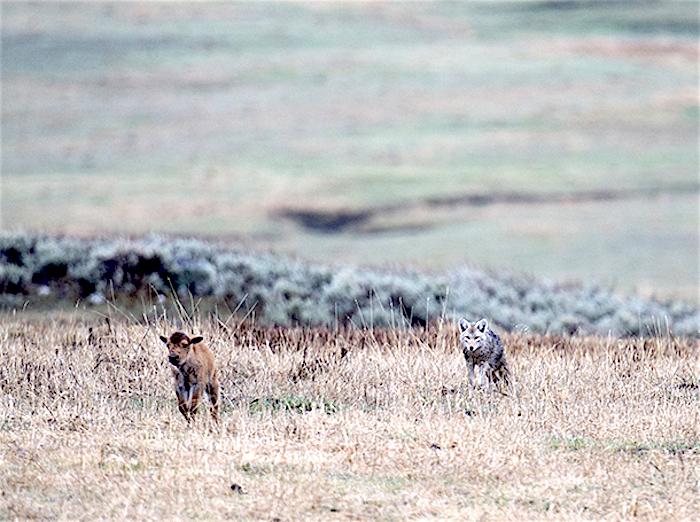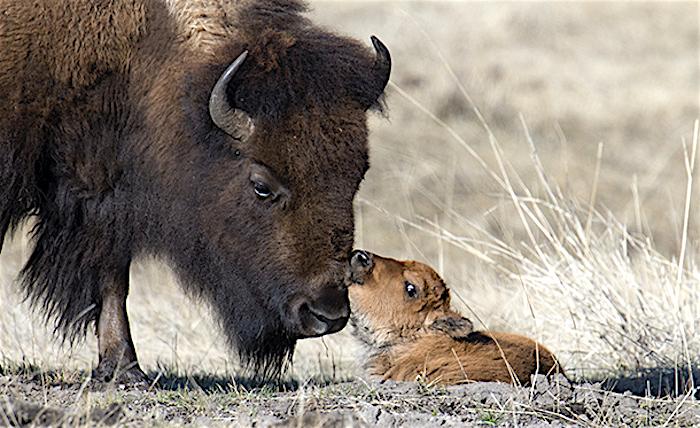
Separated from its mother, this bison calf was photographed a few days before two Canadians put it in their SUV to take it to rangers because it was cold and shivering/Deby Dixon
I met the bison calf who took a ride in an SUV early one evening as I drove west in Lamar Valley, past the pullout known as “Picnic.” The late afternoon sun on a stormy day landscape was the light that photographers dream of shooting, with wild animals on a horizon and Yellowstone National Park's gorgeous mountains off in the distance.
I spotted a bison calf near the road and all alone. The calf was bawling and looking for its mother, but there were no other bison anywhere close by. Instantly, I knew three things; that the calf was orphaned or had become separated from its mother. That the calf would not be adopted by another cow and could not survive alone, and so it was just a matter of time before it died or was killed. And, that I wanted a photo of that calf, in order to remember its short life.

Coyotes prey on abandoned or separated bison calves in Yellowstone/Deby Dixon
Every year, in Lamar Valley, we see bison calves by themselves, destined to perish. Their mothers might have died in childbirth, abandoned them, or became separated during a river crossing. We watch as the calf runs from cow to cow, looking for its mother. We watch the other cows react with violence towards the calf, particularly if it attempts to nurse. A bison cow will not adopt another’s calf. I have even seen calves that have taken up with bulls, which have tolerated them for some time, but were eventually too weak to keep up during the daily travels and were most likely captured by a coyote, wolf or bear.
Earlier this year, I watched a new calf run from herd to herd, looking for mama, while a coyote followed behind. The calf did not know that the coyote presented any danger and often ran right up to it and sniffed noses. This was a heartbreaking sight to watch, with a healthy calf expending so much energy to find home but not finding one. And, that coyote, always close behind. I did see a bull run the coyote off once, but before long, calf and coyote disappeared down the hill and onto the valley floor. To my knowledge, the calf was never seen again.
Yellowstone is wild - the only intact ecosystem in the Lower 48 coterminous states, with the plants and animals that are required to maintain a healthy balance. This is the one place where people can come to see wild bison, wolves, bears, coyotes, foxes, elk, deer, moose, pronghorn, marmots, badgers, weasels, pine martens, beavers, otters, all in one day and living free, as nature intended. Although we get to know certain animals and become fond of them, they are not our pets and we are not in charge with whether they live or die. This might sound harsh but is the way of the wild - it is absolutely breathtakingly beautiful and fascinating, while also having the ability to break our hearts on a daily basis.
I view Yellowstone as nature’s classroom, teaching us about the wild, while also allowing us to see why these preserved lands and protected animals are so important to the survival of man and earth. It is my belief that the wildlife of Yellowstone, when viewed by millions of visitors, are the ambassadors that will enable the animals outside of the park boundaries to survive, because we come to understand their necessity and to care about their existence. Most who come to Yellowstone do not want to see a concrete world without wild animals, clear running rivers, and beautiful wildflowers across the landscape.
But, for most of us, it is only natural to see a wild animal in distress and want to help it survive. That makes us caring human beings, not monsters. I have watched many an orphaned bison calf and felt my heart break for the animal, wishing that there was some way to help and knowing that it would not be the way of the wild world if I interfered. And, so, sometimes, I just have to walk away and let nature take its course, without watching.
I turned and went back to photograph the orphaned bison calf that day. By that time the youngster had grown tired and bedded in the sagebrush above the rushing Lamar River. I went out and took a few photos of the calf with the mountains in the background and watched as every few minutes it would stand up to look around for mom, before plopping back to the ground. As I walked away, knowing that the calf would soon be dead, tears ran down my cheeks and I vowed to not visit again. I wanted to remember the youngster, healthy, wild and free, standing on a hill in Lamar Valley.

A newborn calf nuzzled by its mother/Deby Dixon
So, when I heard that the calf was walking up to cars, in search of mom, I did not return to look. I knew that visitors would be clamoring to take photos of the baby bison and that they would not fully understand its predicament. I knew that some would feel their heart breaking over the calf’s plight and loneliness and want to help. But, never did I dream that some people would put the calf into their car and carry it to the ranger station in search of help.
I do not condemn the people who picked up the orphaned calf and tried to help - I understand their hearts completely and know that they thought that they were doing the right thing. Because, out there on the other side of the boundary where Yellowstone ceases to exist, people help wildlife all of the time. In Yellowstone, many a visitor has saved a calf from certain death, unbeknownst to the park. These people, the foreign visitors, could not have known that the bison calf was an orphan and that no other mama bison would adopt and care for the baby. They could not have known that the calf would certainly die, as nature intended.
The National Park Service, not realizing that the calf had been abandoned or orphaned for several days, attempted to return it to Lamar Valley, but there was no mom waiting for her baby. Rather than let people stand by and watch this beautiful creature of our earth perish or be killed, or, cause an accident as it ran into the road, the Park Service did the only kind thing that they could and they ended the calf’s life a few days earlier than nature intended.
If you are in Yellowstone long enough to see animals suffer and die, you will know that when all was said and done, this was a kind ending for the calf that took a ride in the car.
When it comes to suffering or struggling wildlife, Yellowstone has a policy to not interfere unless the condition was man-caused. The park has, at times, killed a suffering animal, for various reasons, or rescued one that was drowning in Blacktail Lakes where they cannot escape, and so there have been exceptions. But, for the calf with no mom, there was no help.
Our job is to accept nature, on nature’s terms, but in order to do that we need more educational programs that can teach people just what that means. The National Park Service needs more rangers out in the park and interacting with the visitors, teaching them about this place called Yellowstone that we all love so much.
Deby Dixon is a professional photographer who has been a near-daily visitor to Yellowstone the past four years. You can view her work at Running Wolf Nature Photography.



Comments
I have searched FB daily to see any updates on this story, as I knew it would take many twists and turns. Thank you for setting things straight. I hope there is also a fair and balanced agreement between the NPS and those who gave the ride to the calf. Thanks again for this article. I am headed to Yellowstone next month and anxious to show one of my kids its beauty.
Thank you, Deby for connecting the dots, and revealing the facts about the baby bison. While it is a common and sad story, it is filled with compassion and hope for understanding and acceptance. This is a good lesson for each of us. Again, thank you.
Thank you Deby Dixon for this excellent post. As you point out, education is the key. I agree with Maureen Dennis, others, that a balanced agreement between the NPS and the visitors involved can be reached. It appears they were only trying to help. Thanks again.
Beautifully spoken Deby.
Yes, what the visitors did wasn't right but I am glad to hear the full story as it seemed that the National Park Service was throwing the visitors under the bus in order to make a point - certainly from what I had read, I - like many others - had come to believe that the visitors in effect signed the death warrant for the calf, when in actuality they just brought the calf to the attention of the rangers sooner rather than later. But if we are going to talk about the "cycle of life" - what about how we spend a million or more dollars on premature human babies? - we do that ... so would it have killed the rangers to hand over the calf to those who help wild life? No, but they wanted it make a point so they made villains out of tourists. I just hope those tourists get to read the whole story so they can stop beating themselves up and perhaps not experience the wrath of the readers.
Yellowstone's whole goal is to let nature be as best it can and preserve it. Would you have wolf pups go hungry because their parents are stopped by humans every time they try to bring a bison calf home to their babies.
Yellowstone is better off without people like you. I, for one, look forward to never seeing you there.
The park service explained why that was not a feasible option.
http://www.yellowstonepark.com/bison-calf-put-in-car/
Thank you for this enlightening article!!